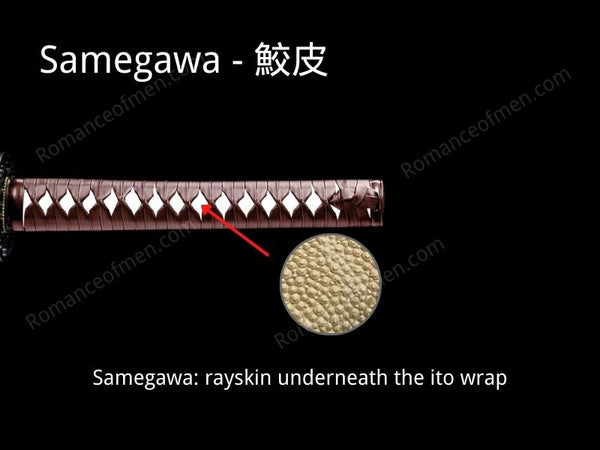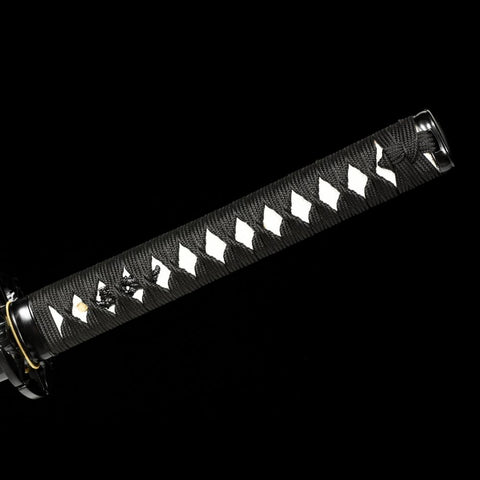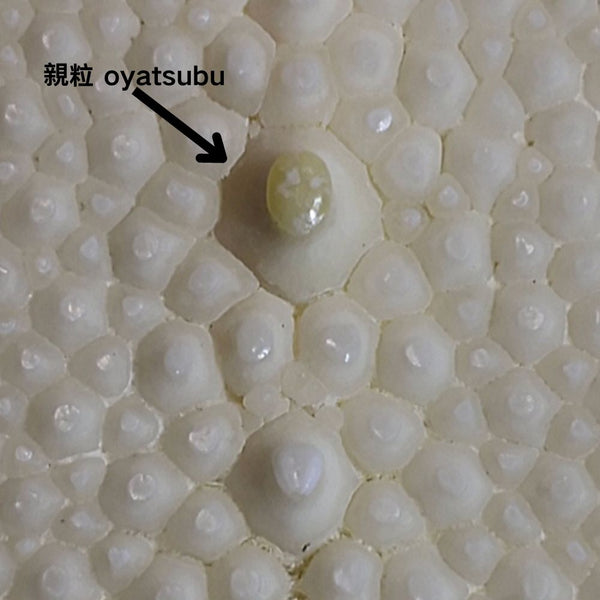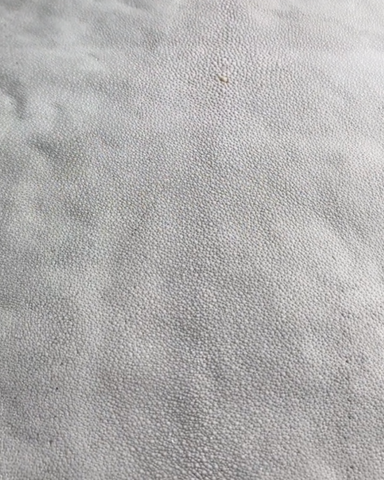Katana Samegawa Ray skin on the tsuka that provides comfortable grip
What You Should Know About The Samegawa
Samegawa (鮫皮) is the Japanese term for shark skin or sting ray, which acts as a binder for the handles of traditional Japanese swords, known as Katana. It is one of the most integral parts of the Katana that increases its durability and appearance. Curious to know how crucial Samegawa is for a Katana? Keep on reading to find out everything about it!

Table of Content
- What Is Samegawa(鮫皮)?
- How to Wrap Samegawa on the Tsuka?
- The Value of Samegawa
- Fake and Real Samegawa
- Other application of Samegawa
What Is Samegawa(鮫皮)?
Samegawa, literally means "shark skin" in Japanese, 鮫 (same) meaning "shark" and 皮 (kawa) meaning "skin". It is a crucial part of the Katana, it is used to wrapped around the handle, provides reinforcement, and to prevent the handle wrapping from loose. It also adds an aesthetic appeal to the sword, making it look more elegant and beautiful.
Japanese sword makers have used Samegawa since ancient times, although it is called 'shark skin,' it is actually stingray skin. The most common species of ray used is Pastinachus Sephen or Cowtail Stingray.
Image source: Wiki Pedia
The Cowtail Stingray is caught primarily for its meat, making the skin a byproduct of the fishing industry. Fortunately, these fishes are plentiful in warm, tropical environments and perfectly edible. So you won't have to worry about their extinction.
What's more interesting is this kind of stingrays are not easy to find from the ocean near Japan, so Japan had to import them from China, Korea, India, etc.
Samegawa Color

White is no doubt the most popular choice of color for samegawa. This preference for white samegawa became especially popular during the Edo period. because the white color made the texture of the ray skin easier to see and appreciate.
However, during turmoil times like the Sengoku period, using white samegawa wasn't common for swords meant for battle. Samegawa were often coated with black lacquer to make it waterproof, protecting it from getting loose due to moisture from rain or blood. This practical approach was necessary for swords used in combat, where durability and reliability were crucial.
The preference for white samegawa in the Edo period reflects the era's peace and the shift towards more aesthetic considerations in sword making.
How to Wrap Samegawa on the Tsuka?

Image source : Bigport Leather
The Tsuka (handles/hilt) of a Samurai sword is wooden, and the sword's maker uses the Samegawa to wrap around the tsuka to secure it. Here are the steps:
Making the Samegawa Ready:
First, the Tsukamakishi (means handle wrapping craftsman"柄巻師") gets the Samegawa ready by wetting the dried skin to make it soft. They clean off any dirt with a rough brush and then polish it with a bamboo brush and some sandpaper.
Shining the Shark Skin:
Next, they shine the Samegawa using a special brush called "udzukuri," made from dried grass roots, and ibota wax, which comes from a plant's bug larvae. They keep polishing it until it looks shiny like a gem.
Wrapping Samegawa on the Tsuka:
After the Samegawa is ready, they wrap it around the tsuka, tie it with a string, and let it sit for a few days. This might need to repeat a few times to make sure it fits just right because the Samegawa can stretch or shrink with moisture. They use a special glue to stick it on when it fits perfectly. After this step, the tsuka will be ready to ito wrapping.
Given its longevity and resilience to wear and tear, Samegawa is a common choice for katana handles. Sometimes the Tsuka are covered with Samegawa only, without the Ito wrapping. You can see this on some Tachi, although it was more frequent on the shorter Tanto swords. You will also see Samagawa on the Saya of the Katana, or sheath, to improve grip or serve as a decorative accent.
The Value of Samegawa
Samegawa is exceptionally durable, coarse, and sticky. Authentic Samegawa is an organic material made from dried stingray skin. Typically only featured on the high end Katana, this is a very pricey material.
Stingray skin is smooth on one side and has a very rough texture on the other. The largest grain in the middle upper back is called the "parent grain" (親粒 oyatsubu), and the size of this grain determines the value of this piece of skin. Larger grains indicate a larger piece of shark skin, making it more expensive.

In Edo period, Samegawa with excellent quality can value more than 15 ryō (両, a a gold currency unit used in ancient Japan), that roughly equal to 3 million yen today's currency. Consider the law in Edo period will execute the thief for stealing over 10 ryō, Samegawa is a very valuable item. Don't be surprised if a katana's Samegawa value more than the sword itself.
If a craftsman finds a shark skin with very large grains, they won't grind it down to use on tsuka. Instead, they make a 'presented shark skin' 献上鮫 out of it, keeping it as a memento, for enjoyment, or to give as a gift usually to their Daimyo.

Samegawa, Full wrap or Panel?
Nowadays, A single sheet of ray skin can cost anywhere from $100 to $200. No doubt, Samegawa is pretty expensive. We know that traditional Japanese katana will use the entire sheet to wrap the handle, that's true for Japanese made Katana using tamahagane, strictly followed the ancient sword making methods, their price is high enough to include the cost of full wrap samegawa.
However, due to the high price of ray skin, most mass-produced katana (And some Gunto during WW2) nowadays use panels of samegawa in the handles. These small piece of ray skin were leftovers after an entire sheet of ray skin was used for full wrapping.
Panels are much cheaper than full wrap, but the quality will of course compromised. The grains in these panels are unlikely tidy, the panels are often came from different sheet of ray skin. As for functionality, full wrap samegawa provides much better gripping experience than panel ones. If you plan to use the sword very often for practice, it's recommended to use full wrap samegawa.
Fake and Real Samegawa
There are also fake ray skins made of plastic available in the market. These imitation fish skins are typically used on low budget katanas, especially anime katanas that weren't made for actual use. Although it also has a grainy texture, it's not difficult to distinguish because it doesn't look as high-quality at first glance
How To Tell The Difference Between Real and Fake Ray Skin?

Usually a good katana over $200 should use at least panel real samegawa. But you might notice many self-proclaimed high-quality Katanas sold for hundreds or even more dollars, still using fake samegawa.
Experienced sword collectors can take a closer look at them and know that the Samegawa on their Tsuka is far from authentic. But if you are new to the world of Japanese Katanas, you might not be able to tell the genuine from fake. None of us want to end up spending our precious money on counterfeit products. So how do you tell fake Samegawa from a genuine one?
Grain Pattern: Real samegawa has a natural, irregular grain pattern because it's a natural product. Each piece is unique, with variations in size, shape, and distribution of the grains. On the other hand, fake samegawa, which is usually made from plastic or other synthetic materials, often has grains that are too uniform and artificial-looking. The consistency and repetitive pattern of the grains on fake samegawa are giveaways of its inauthenticity.
Heat and Needle Test: This is a more reliable test where you heat a needle and try to pierce the samegawa with it. Real samegawa, being made from tough, dense ray skin, is very resistant to high temperature, so a heated needle should not be able to go through it easily, if at all. Fake samegawa made from plastic or similar materials will melt or allow the needle to penetrate because synthetic materials cannot withstand the heat like real shark skin can.
Touch and Feel: The texture of real samegawa is very distinct; it's hard and rough, similar to sandpaper, due to the natural grains and toughness of ray skin. This texture provides a good grip when used on katana handles. Fake samegawa, in contrast, feels more like plastic — it's softer and lacks the coarse, abrasive quality. You will immediately tell the difference once you touch them.
*Our custom katana service offer real ray skin for samegawa in various color as well.
Other application of Samegawa
鮫鞘 (Samegawa Saya)
Image source : touken-world
Ray skin scabbards became popular around the Genroku era (late 17th to early 18th century). They were made by wrapping scabbards with dried, tanned ray skin, then painting them with black, blue, or red lacquer and polishing with a whetstone to bring out various patterns.
These patterns could include fine mesh, bead, plum blossoms, stars, or butterflies. These ray skin scabbards serve more than decorative items, but the hard ray skin also made them very durable, protecting the sword from cracks, scratches, and rain. This practicality led to their widespread use from the Muromachi to the Edo period.
To make a samegawa saya, only one part of a ray fish's back skin can be used, that means many material was wasted, makes such a saya very expensive.
鮫皮おろし (samegawa oroshi)
This is a Japanese grater made from shark skin. It's traditionally used to grate foods finely, such as wasabi, ginger, and radish, giving them a smooth texture that's hard to achieve with metal graters. The shark skin's rough surface makes it perfect for creating a fine paste, enhancing the flavor of Japanese dishes.
Conclusion
That’s all on the Samegawa. It is a crucial part of the katana with many historical and usage significance. Hopefully, by now you have an in-depth idea about this part of the katana. For more katana parts info you can check our katana anatomy guide.























